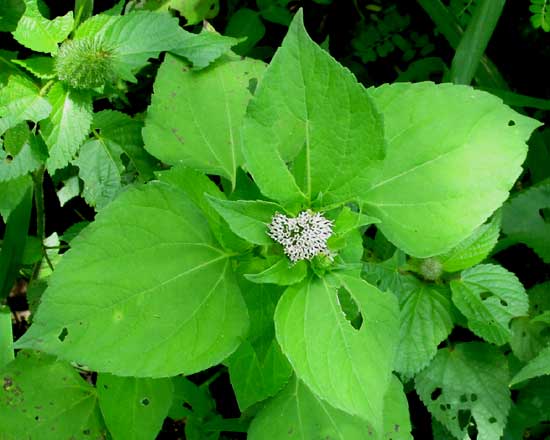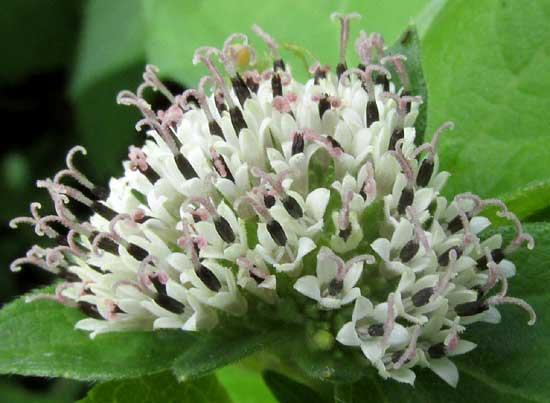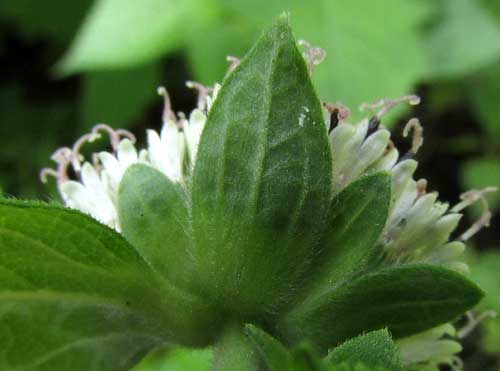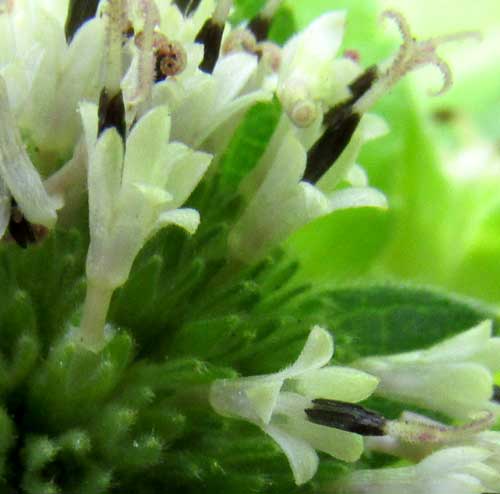Excerpts from Jim Conrad's
Naturalist Newsletter
from the August 14, 2016 Newsletter issued from Hacienda Chichen Resort beside Chichén Itzá Ruins; limestone bedrock; elevation ~39m (~128ft), N20.675°, W88.569°; central Yucatán state, MÉXICO
SILKLEAF
Along a weedy trail in the Hacienda's woods an herb about a foot tall currently bears one or a few clusters of white flowers above relatively large, heart-shaped leaves, as shown below:

Even at a distance, with all those small, white flowers clustered so closely in one a flowering head, this looks like a member of the Composite or Daisy Family, the Compositae. The leaves are similar to those of certain sunflower species, also of that family. Below, up close, we see flowers that are definitely Composite Family:

One Composite Family field mark obvious here is that from each corolla there extends a branched, Y-shaped style, the base of which is surrounded by five blackish anthers united at their sides into cylinders surrounding the style's base.
In the Composite Family, each corolla arises atop a developing ovary. The ovary, corolla and sexual parts all constitute a floret, not a regular flower. The head with all its florets is further subtended by leafy, scale-like bracts which form the head's "involucre." We seem to be seeing all that above, but there's something very unusual: Green, scale-like items appear beside several of the florets within the floret grouping. If this is real flowering head, those green items shouldn't be there.

Looking closer into the head, we see more leafy things that shouldn't be there. It's apparent that all the clustered florets are not gathered into a typical head.

In the end, finally it was realized that in this genus the great distinction is that clusters of florets such as above actually consist of several to numerous "real" flowering heads, each with its own involucre. What at first appeared to be the green involucre below the florets was just leaves modified to do the service of a real involucre. Our plant has a "composite head composed of composite heads," with each real head containing only a single floret.
A genus doing this is the mostly Mexican Lagascea. Our species is LAGASCEA MOLLIS, a common weed that's spread nearly throughout the entire tropical world. Among its English names, Silkleaf may be the most commonly encountered
Silkleaf is fairly common here in weedy areas, and often you see several individual plants forming a small community. A research paper by Elizabeth Murillo and others, available on the Internet, explains why that might be: Silkleafs are "allelopathic." That means that they produce chemicals that retard the growth of other plants around them. Murillo's study found that Silkleaf extracts have a "significant effect on cellular division and radicular growth" (early root growth) on oat seedlings. Since oat plants are grasses, this raises the suspicion that Silkleaf might not be the best weed to have in fields of rice, corn, sugarcane, wheat and rye, which are all grasses.